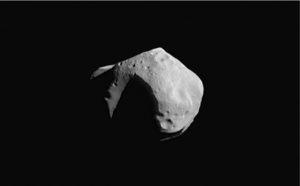
 Have you ever wondered what piece of cosmic debris is whizzing past the Earth right now? Do you crave up-to-the-minute information about asteroids large and small? Well you’re in luck because today you can subscribe to a new service: the Daily Minor Planet.
Have you ever wondered what piece of cosmic debris is whizzing past the Earth right now? Do you crave up-to-the-minute information about asteroids large and small? Well you’re in luck because today you can subscribe to a new service: the Daily Minor Planet.
Developed through a partnership between scientists at the Minor Planet Center and volunteers from the Oracle Corporation, the Daily Minor Planet will deliver reports on the latest asteroid happenings straight to your inbox.
“Most people don’t realize how common asteroid flybys are,” said Matt Holman, director of the Minor Planet Center and astronomer at the Harvard-Smithsonian Center for Astrophysics (CfA). “We want the Daily Minor Planet to educate readers in an entertaining way, so the next time they see a doom-and-gloom asteroid headline, they’ll know where to go to find the facts.”
The Daily Minor Planet’s name cleverly combines the title of the fictional newspaper home of Superman’s Clark Kent, the  Daily Planet, with the historical name of asteroids, or minor planets. In a nod to the real-life newspaper world, it will be available in two HTML formats: classic and modern.
Daily Planet, with the historical name of asteroids, or minor planets. In a nod to the real-life newspaper world, it will be available in two HTML formats: classic and modern.
Almost every day, a known asteroid passes within a few million miles of Earth. On those dates, the Daily Minor Planet will list the flyby asteroid along with the time and distance of its closest approach. On days without a cosmic flyby, the report will feature a newly discovered asteroid. It will also highlight an article from the popular press.
The Daily Minor Planet continues a collaboration that began with Asteroid Explorers, a website designed to increase public awareness of asteroids and their impact and risks to the world. That website’s interactive tools allow visitors to investigate questions like “Which asteroids have the highest risk of impacting Earth?” and “Which asteroids are easiest to travel to?”
“I want to thank the Oracle volunteer team and the others for their excellent work on the Daily Minor Planet and the Asteroid Explorer,” said Victoria Friedensen, the Planetary Defense Program Executive for the Asteroid Grand Challenge at the NASA Planetary Defense Coordination Office. “These are two excellent examples of how government, academia, and the private sector can work together to improve our defense from an impact on Earth.”
Smithsonian astronomer J. L. Galache served as project lead on both the Daily Minor Planet and Asteroid Explorers. His colleague at the Minor Planet Center, Michael Rudenko (CfA), played a key role in designing and implementing both websites.
 For the Daily Minor Planet, the Oracle team focused on taking the Minor Planet Center’s complex data sets and creating intuitive visualization tools.
For the Daily Minor Planet, the Oracle team focused on taking the Minor Planet Center’s complex data sets and creating intuitive visualization tools.
“Humans are visual creatures. And although our target audience is everyone, we found that even the experts can understand the data better if it’s well visualized,” said DJ Ursal, senior director for the Oracle User Experience Organization.
“Our measure of success is community impact,” Ursal added. “It’s all about community and participation, cross-organizationally at Oracle and out in the wider world.”
Jeremy Ashely, Oracle Group Vice President, agreed and pointed out that the relationship between Oracle and the Minor Planet Center has been mutually beneficial.
“A project like this gets people to stretch their minds,” Ashely said. “It’s easy to get into a rut, but when you gather different people together and they bring different perspectives, new ideas start to emerge. That’s the definition of innovation.”
To subscribe to the Daily Minor Planet, go to minorplanetcenter.net/daily-minor-planet


Be the first to comment